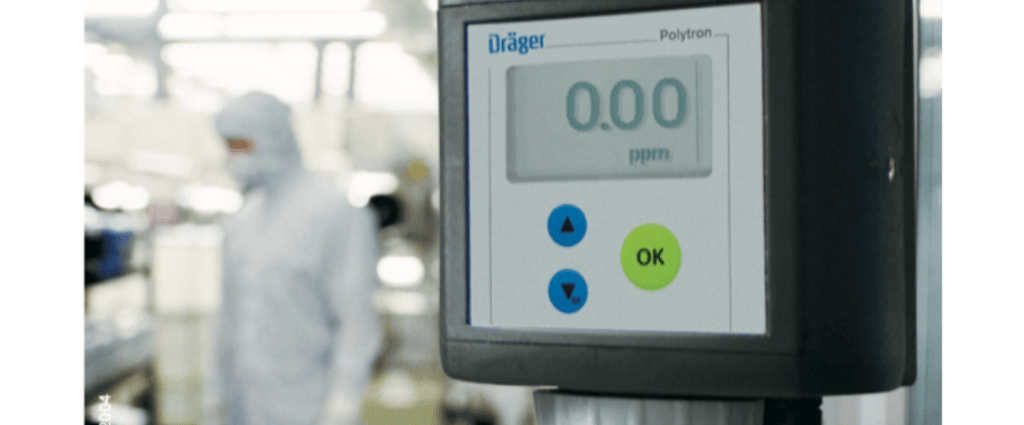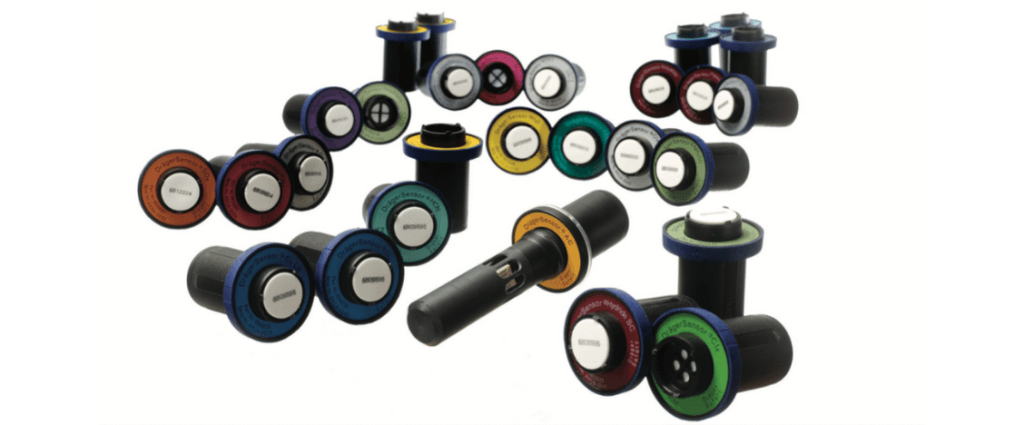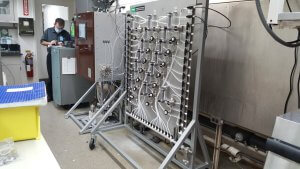< Product News
Using Vaporized Hydrogen Peroxide for Bio-Decontamination
February 24, 2021 | Product NewsIn 1994, Dräger introduced the first electrochemical hydrogen peroxide (H2O2) sensor for monitoring low concentrations of vaporized hydrogen peroxide (VHP). VHP became the preferred substance for decontamination due to its bioactive effect of killing bacteria. Today it is used in filling machines, barrier isolators, glove boxes, workbenches, and entire rooms.
Vaporized hydrogen peroxide (VHP) is generated by actively vaporizing an aqueous hydrogen peroxide (H 2 O 2 ) solution and injecting it into a room. Achieving a high level of microorganism bio-decontamination requires a defined high VHP concentration and exposure time. VHP is rated harmful to humans. As a result, many countries have imposed an occupational exposure limit value. Values in the United States for both 1993-1994 ACGIH TLV and current OSHA PEL are 1 ppm (1.4 mg/m 3 ) TWA. Staff outside a fumigated room or facility must be protected from accidental contact with H 2 O 2 vapor. At the end of a sterilization cycle, the room or volume is rinsed with fresh air. An air analysis is necessary before it is safe for staff to enter the room or bring in new, sensitive material for a production stage. The concentration of H 2 O 2 must be reduced through ventilation to non-hazardous levels, usually less than 1 ppm.
The generator that creates the H 2 O 2 vapor for sterilization can also pose a risk to staff, which is why the generator‘s environment and connecting hoses need to be monitored for H 2 O 2 gas leakage.A risk analysis is necessary to satisfy regulatory guidelines. The purpose of the analysis is to identify all potential sources of risk, and to define measures to control exposure using gas measurement instruments, personal protection equipment and operating instructions.
Challenges

Properties of VHP
VHP is a vapor – not a gas. This means that the H 2 O 2 concentration in the air never exceeds the vapor pressure at the corresponding temperature (and pressure). Above the saturation point (dew point), H 2 O 2 vapor starts to condense as an aerosol or on surfaces.
H 2 O 2 is completely soluble in water. Solutions of 30% to 35% H 2 O 2 are common for applying VHP. As vaporization of water is 15 times more effective than that of H 2 O 2 , the aqueous solution has to be actively vaporized, such as on a hot plate. When H 2 O 2 is exposed to condensed water, the solution absorbs H 2 O 2 and the VHP concentration in the ambient air diminishes.
H 2 O 2 is an unstable compound. It decomposes to form oxygen and water. Thus, the concentration of H 2 O 2 is constantly decreasing, which is why stabilizing chemicals are added to the aqueous solution. During active vaporization, these chemicals enter the fumigated room, and may condense on surfaces.
H 2 O 2 is highly absorbent. A loss of concentration through absorption by the surrounding air and on surfaces can be observed. To saturate a surface requires a certain quantity of VHP. Thus, smaller concentrations are more heavily influenced than high concentrations. In pumped systems, the hoses adsorb H 2 O 2 on their surfaces before it reaches the sensor and can be indicated. This loss and the accompanying delay in measurement must be taken into account. When rinsing with air, this effect extends the rinsing times of H 2 O 2 outgassing from the surfaces. DrägerSensors® measure H 2 O 2 vapor as a volume concentration (ppm).
Material compatibility
H 2 O 2 is a chemically aggressive compound. Dräger transmitters and sensors are made from a chemical-resistant plastic (polyamide 12 blend). If high VHP exposure will be frequent, the transmitter should be installed outside the VHP atmosphere in a way that only the sensor extends into the measurement room (remote sensing). Any use that deviates from specified conditions must be verified by users on their own authority.
Calibration
Because of the physical and chemical properties described above, calibration with hydrogen peroxide is not easy to perform. VHP has to be generated with resources under laboratory conditions, and the concentration verified with an analytical device. This is not possible in the field.
Dräger offers factory-calibrated sensors. The calibration information is stored in the sensor. For recalibration, the sensor can be removed from the transmitter and sent to a Dräger Service station for H 2 O 2 calibration. A spare sensor continues to measure in the interim. Sensors are supplied with a calibration certificate, which documents the measurement values before and after calibration. DrägerSensors for H 2 O 2 have a cross sensitivity to sulfur dioxide (SO 2 ). The empirical ratio of sensitivity between SO 2 and H 2 O 2 is known as relative sensitivity. This value has a statistical spread and does not have a guaranteed constant time. The tolerance for new sensors is ±10 %. For reasons of accuracy and reliability, it is therefore preferable to calibrate with the H 2 O 2 target gas instead of a substitute calibration with SO 2 . Other performance specifications are available in the datasheet.
Dräger H 2 O 2 Monitoring Solutions

Workplace monitoring and leakage detection
For personal protection, workers should wear a portable gas detection device that alerts them to exposure wherever they are. For area monitoring, a stationary gas detector monitors a defined area. It is important that stationary gas detectors be placed in an ideal location to detect gas quickly and reliably. To ensure this, it is necessary to inspect and consider gas dispersion and airflow.
Cycle parameter control and safe entry measurement
A sterilization cycle for isolators or cleanrooms can be divided into four phases. The first phase in a fumigation cycle is dehumidification. During this phase, air from the target room is cycled through a dehumidifier to reduce air humidity. This takes about 20 minutes, depending on the volume of the room. In the conditioning or fumigation phase, hydrogen peroxide is actively vaporized at a pre-set injection rate and fed into the room. This takes about 30 minutes. Sterilization is sometimes also called the “dwell” phase. The VHP concentration is kept constant for a predefined duration of exposure Pre-configured process parameters are applied during this phase.
The parameters have been determined in the application validation for the required microbiological extermination rate.
Ventilation is the longest phase in the cycle (up to 5 hours). VHP is no longer pumped into the room. The air is fed through a catalytic scrubber or replaced with fresh air to lower the concentration of H 2 O 2 to a pre-defined threshold value. The fumigation cycle, specific to each device, must be qualified and validated in compliance with Good Manufacturing Practice (GMP) rules during consignment. Chemical (CI) and biological indicators (BI) in the device or room measure the extermination rate. The programmed process parameters for VHP fumigation are derived from this.



